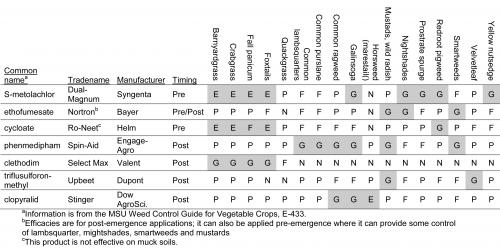Herbicides for in-season weed management in red beets
Available herbicides target a variety of weeds in red beet production.
Weed control in specialty crops like table beets is challenged by lack of herbicides. Bernie Zandstra of Michigan State University has conducted research to determine how existing products can best be used to control key weeds in red beets. Products can be chosen based on their ability to control problem weeds specific to a location, and include both pre- and post-emergence products. Note, all herbicides will injure beets to some degree, but they can grow out of the injury if rates are appropriate and conditions are right.
A partial list of pre- and post-emergence herbicides available for weed control in red beets, which research suggests provide excellent “E”, good “G”, fair “F”, poor “P” or no control “N” of select weed species. Efficacies and potential for crop injury will vary with environmental conditions. Shaded cells highlight weeds an active ingredient may be good or excellent at controlling. For more information, consult the MSU Weed Control Guide for Vegetable Crops (E-433).

Download a printable/larger version of this table.
Products available for pre-emergence weed control
Dual Magnum and Nortron are available for pre-emergence weed control in red beets. Dual Magnum is most effective at providing a few weeks of control for grasses and broadleaves including redroot pigweed, nightshades and yellow nutsedge. Nortron can be used alone or in combination with Dual-Magnum to provide control of some additional broadleaf species including common lambsquarters, nightshades, smartweeds and mustards. Nortron is only available for purchase in pallet-size quantities. For sandy soils, Ro-Neet is another option that can be used to provide control of grasses and redroot pigweed. Note, an old standby, Pyramin 68DF (a.i. pyrazon), is no longer available. For more details on how to apply these products, consult Michigan State University Extension’s Weed Control Guide and the product label.
Products available for post-emergence weed control
Post-emergence herbicides can be applied after beets have emerged and can tolerate some herbicide injury. It is critical to use the lowest rate for these products the first time you apply them as they can all injure beets. Select Max can be used for grass control at any time when grasses are actively growing. Spin-Aid provides control of broadleaves including common lambsquarters, purslane, common ragweeds and mustards, and can be applied when beets have at least four true leaves; do not apply if plants are under stress. Upbeet can provide control of velvetleaf and mustards, in addition to suppressing lambsquarter, pigweed, nightshades, ragweeds, smartweed and wild buckwheat, and can be applied when beets have two to six true leaves. Stinger can be used to control composites such as horseweed in addition to nightshades; it should be applied after beets are at least 4 inches tall.
Choosing herbicides
To choose products:
- Consider which weeds are likely to be challenging in a particular field.
- Make a list of candidate herbicides for pre- and post-emergence control.
- Determine the appropriate time for application in relation to planting and crop growth stage.
- Keep track of weed pressure and crop development to time applications.
Note that efficacies and crop injury can vary with local environmental conditions. Consequently, if you decide to try a product you have not used before, consider using a low rate on a small percentage of your acres to minimize the impact of any crop injury and get experience with what your beets can tolerate.
For more information on herbicides for red beets and other crops, consult the MSU Weed Control Guide for Vegetables (E-433) and always remember to read the herbicide label.



 Print
Print Email
Email

